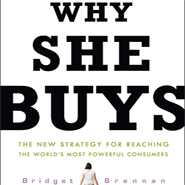by Bridget Brennan
Chapter Five
Marketing to Women: The difference between sex appeal and gender appeal
For MasterCard, a good story is priceless
When marketing to women
MasterCard Worldwide and the team of people at its ad agency, McCann-Erickson Worldwide, provide a superb example of how one company has mastered the art of gender appeal.
The “Priceless” campaign has leapt over the walls of marketing and made its way into pop culture. It appears in 110 countries and 51 languages and has been running since 1997.
The campaign is worth studying for many reasons, but for our purposes, it is because the folks at Master-Card have perfected the art of emotionally connecting to the world’s most powerful spenders, women, while still retaining the brand’s appeal with men—not so simple in a sector of the financial industry that has all the warmth of sheet metal.
“Priceless" ads tell small but perfectly-formed stories about all the things in life that money cannot buy.
“The campaign is deceptively simple, “ says Amy Fuller, who runs marketing for MasterCard in the Americas.
“But it’s unbelievably difficult to find the human insights that becomes the content for the [television] spots.”
Amy has one of those jobs that everyone thinks they can do.
Perfect strangers give her their ideas for “Priceless” commercials when they find out what she does for a living, because Master Card makes storytelling look easy, the way Tiger Woods makes golf look easy.

The details are what’s different
Universal needs such as love, time, family and children are all considered priceless by most people, but these generalities do not necessarily make for compelling marketing, because there is nothing surprising about them.
The details are what this campaign does well.
The “Priceless” commercials depict life’s golden moments through the seemingly insignificant things that make up our days, like a ready-made lasagna, a pedicure, a rubber ball or a box of Goobers candy.
It is the specifics in the campaign that make women think, They’re talking to me—that is my life.
Time after time, MasterCard displays a fundamental understanding of female psychology.
For one thing, the campaign’s creators clearly know that women rationalize their purchases, especially when spending money on themselves.
Men just don’t seem to have the same guilt gene that women do.
In one of my favorite executions, a commercial called “That Would Go Great with That,” MasterCard demonstrates how one small purchase has the domino effect of leading to bigger and bigger ones.
In the commercial, which features a woman who could be described as lovely but not unattainably beautiful, every new purchase the woman makes is justified by the previous one.
Take a look at the copy, which is read to great effect on television by the campaign’s regular male announcer for U.S. ads, actor Billy Crudup.
Pedicure . . . $28 on debit MasterCard.
Peep-toe pumps to show off your pedicure . . . $96 on
debit card.
Adorable dress, to go with your peep-toe pumps that
show off your pedicure . . . $150 on debit card.
Cut to a screen shot of the woman admiring a beautiful necklace in the window of Tiffany’s, until the voice-over says, “Yeah, right.”
She rolls her eyes, smiles and skips away, laughing at herself for thinking she could justify expensive new jewelry just because she got a good pedicure. She had gotten carried away.
The voice-over closes with: “Living in the moment, priceless. There are some things money can’t buy. For everything you must have right now, there’s debit MasterCard.”
The insight of this ad is that MasterCard understands how women shop.
Women do not have a linear purchasing style.
Rather, the act of buying one small thing can snowball into a series of unplanned purchases. Interestingly, a woman creative director has run the “Priceless” campaign since its inception.
Her name is Joyce King Thomas, and she is still with the campaign’s original agency, McCann Erickson.
“Both men and women like the campaign because we take things to a human place,” says King Thomas.
“If you can find some big human truth, it’s always better than a purely functional message. The two pieces of this campaign are head and heart. We start with the functional benefit—that you can use your card to buy these things—but we know that there’s more to life than money, and that people want experiences, and something more soulful.
Women respond to that, but we also have big, burly men cry when we test commercials.”
Joyce is that rare bird, a female creative director at a big New York ad agency. Is it a coincidence that a woman has led one of the world’s most successful and longest- running campaigns? You already know what I think.
This excerpt has been adapted for style.
Excerpted from Why She Buys: The New Strategy for Reaching the World’s Most Powerful Consumer
Copyright @ 2011 by Bridget Brennan. Reprinted by Permission of Crown Business, an imprint of the Crown Publishing Group, a division of Random House, Inc., New York.
{"ct":"s3CVjlSTV0lzHvtb1sbxCiZSZL1\/Zjt2tB5i\/\/dNo84k3Xps\/Sn54JtKGpKel8nmvV7gJK2e2DTv5MpYU7J0KC1bCPB1JVFZKzRR546YhLL3J\/kmkETpwlv3+89BMuJkDFjpZMsBDgZKWCk32D5d7KRlp2t7O5UeFqSiIzrjnzNqoi3\/njhNeTtGxogSzylgWEO+vrG6BQqTP2Eovoa06GnpOe6w\/Z22r0q5UkEinpP07\/qIzWQ2Qg+wBNokA3Rwc01QvaSoXOMlzPbEX8866sZUbaC4bB7zCA3SFK44gtS3B6XLL0R+Gl940hyJ7mCarbb1a0CeWC6mHfulpm7U+70InrddzHeYCxxzE\/oNvMBtpW1qU86EL98cJhmGccT138X28FDbQiHWqYsDY4xSUspY36IKCLko1R\/bukSkz3V6QVJBj1PCAtdW8eUIKzbTuxJ6cuRDSi+w6P1JpPP2m2sryxo8mhbLHMhPLKGxi9LI8VmeiV3uZac7EPTgWSIQvSqn7kvySf2ebXRoHoNro0WDbeIFfOk0XEzta1joHj8EZZKxNp78QW676UCqb6K5g3ZCUKIFUn2Uu4nYUFMB6ag7BieJWzZ9fCYeBlwBtR02VO0g1C4QwMQGu5LFReHemqui85nvpE4ADTblNlpbv5CfihFf3Dt8NJaapdbxc75jAatuFK5x3by3AwjyswBkcS0VNrYCfc+Z3LT6H5Wq5YuQqjOiwzKJxySAg2ix3nl\/BIl5pAYg17VDjagut4YNe9EqDFpMw97YEay+tBDZ7\/gMdxIAzPxg67G1WIG\/U8Rfd2XIsf6Dmw5moGvM3toNCNeRhzePhgeOi72TVNFvgaDUkfH1+5uX8YVNQ8a0Bsp0UQGWpzV+F3T3KuU9N8NtNfGa7RabEqroL3xkH4\/ok4FKoXYeVxKpdKIaIDZxjBv7jMV7v5UF\/fU3fqefaY8+tllYq0eedn0FHcWDrO6e163TAmRMIhGSXDWMf6aNlg\/+AYi8gBVqXYu0jdATpVXGHg3oHKqzeZdGQOlG32MTzRqSg0t+BZEj+z7Ni37XfjxhzziU4vS2mOMYpODjubkED49MuD9pAmJedpZq724UVddSht77CPKq8qhbCJGcZspphYE6IzF\/bCZYOSTNDRCqiudNkNGPN7OEkZcf3fFhlSZUcwFvuc82Qpy2sIRazGSVUTX72UN04y54LzgDNJ+igCDE3h0bHeXmzZbnFMOAneaAKa2k2B6xNQUBMLlEW+Gx0k4SePKTznI3YEGd2GcJMtPSuf+ad9SY4t+KcPsXWZgEkWe573yZFY\/n4oXJK6mRcD4CCzpaUf8B4\/pDlfA4SCLJ53+4qpoMX0seaSiQ3lvdMnSIc9w2dRnT2fsObVzN\/+q7ZEe0kNgIqbgdQI0HSKbFZsm4evC+RPG2HpdKFYCH\/bgxaiTBqRzLlysmZuJimRTGhhzq9CoXwtihfZAh7n35ttguKDhL9Dw2ZiIg\/eUItm9bd3sEQ7ZZmOrCSEMsk1X5KJB1LAAOfYTX31e7eC1xiOQ13s+PwmJjhlc7Ka8Wsk4Dwx+xfAK9F87v4dKIZ+T5JiFn4wsryGtQ\/FU4Jq7zVi8\/w2VJ0KK6Qk0WGvFEvTTuDDGpjbWiP7Hui7t+mfeQJWFtYi5b9p1rMgGeB0asGKv9RlosXIumpDB7o2w6CZP\/9q4cR1a2aX4Pv6SSh7Wni8i0thJwx\/4ibbg9gqtjTC64Y9erQ48T3nEtSJ9fNpzUmBChdh1J5qe\/Gvat6tiZn+IJ98h7yZDdKuQw+0clIQsw0oro4\/L1rRwN0SNe3Cm3wYLZ71rZuVwbcHNl20PiQ9iAaMpOF8ZNKpPW5wyop1\/2RJOt6of0YrO2NU0rOLlTfcnX3XxyHWOdfezxdP4P5xh17gjK0qc2eixF\/uy1rb\/LFrGBqUqRKAdb6KQi8Cc9dJKHxJ68x\/ZegmVJ3bsuQzwMPQ0nqKFN8z+Cn+d6EM4gUwd0FhKyNQgcR5KY0EPd5excqA4l8VnzBuPCwzQs5EM32aVOYGdUTNnqXv6zUfPD9tkBfUrc7RWt4tSPwZE4ILTmT6fCVdlQsujKg3qKOu1LIo5oBDTL4nWi9h9UefA0KCms0D+bKQwRTFxxMyu6d0hpwCxriL1l8PCoCJ2XNm5hXh61ZKUuOs4QbF+stWhjbkZqr7XobJFg7AB3ee2xmy4WjRUy9wx40CUpb2+R4jkadjb4n8jHOBQt\/Y1b9B4OaWfvz3AAel1DAjHgE6dZ6aTrDzEUxx5aeLfJOH4zbzBNIyMP7GUQYUnLgCdUYFB6NbNH4inSNl2fPA27dPGL2ESDQkg1mlLY1v5c\/Zk4lcrZQD8jjEvf+qXCJ4HU2AQE1yyiGhHOMY6aSbXb1pdNwWxo50xgDgMNUTnPf3vMGz5ChJfN9+QOdQlsJnlzLsOfWyY1ID8NCcJqe524k4zLkYzLsoNrhH\/l19AcF1CL80Icjb7bhG8WFvP7zQ1eaWQHUMZGvydj8q\/MIGMlG8RrO8FKquBisd59WySWe7jF6cPuCCQx3Cn+hYFgKYPqMjmGEB8PU4bTMuBgzVqG6pWyj05RWhVzxZW4c38T9xynC9x9pffaThO7c\/fmQS\/XdHbw5n\/SCUGac3T04x1Gef1nW2\/I5be6gUYP8sUBleNiIRv1KBgdg8Sm9i6tZUKZ4R4x6a8a+3UYTSyZkIUfCULqxYVoLjra1UBWJHRKA6NlL3O8A4L0Z9xUmPP7aLUcxrrS0pNzITIXS9KzqEuX1qMEuPZncpSI6kY99v3eMU2Wa6x+AJ0dSuh\/oa28ZykPI0bXIzPiMz4NtpguZRArombjGuSllM01sAVHWGyg8XojYcJ49LzgjSrq\/+YVy9F5aatRMYDePtDIJhoEXj3oCsvlrVaLqBjKA6rC58+jd5F9BisbtgB+bqvSCvDcfROtZZOR07Omyo+xqFKWkzmLtU7DOK83qsnKkFUKhHS0QWBGc6WyYjIgIZWSAyfve6oVscdHoesM\/cQ82BtBXQ\/G71W32xm4NyyXm+XRyONDM2M7MBxjIr+IX0OR+1w3QVv0wTifM6ZEqiMRQBC9Y3WWbtSWVjzJE4MlQm01ABBO7dw+WClkHdMSphI8x149U5rCuSJKAVV00\/NqQYZp\/HBbrtkUf8eF9e4A2BIrny3JB9uNOy80vWoFa4AuKfFmfNZ+f+FNiMFhPutDDvgnFozxZYtxXshylNL2RootDqHNdPrFlNxQ4Aesy9jH\/W4of+91gqmBpwni\/Scr9W+wNyHTfPwudlXLCROD1jzOS2zyWekROKUlek5BdXHu5SXLIirj9QKmG0RcpmfNDb3OxmmMRA4\/VqQBf9RTwfIIar97KVyU6\/1zX+5ex6TeFF+RJTh52zIVnFn61FHPdfVEhva6xi8OnY9Dbs5pl5\/vhAQTvNj3FMXSsopGgi3dKIju15gBDbRD0LL4MeEy0RIzEt0Ap9B4LMYBkBonmORmHFTb3Wpg1I1L92XsCgJprHpimXupTGSZCDYllCuNmCcUToTWg1MnfjNXZc35ZuGnb13WhkSWVKtxJHTpXYCktjR6oV5U794kEGt5SaoGTC6ntUXaOcEDWCOd4oam0KrgaV+niCJYV9SvX7FKnyYjEPGVjzoZskVT5Oc2Z2DasCJScduy+YWqq5xnk3i8gTizJpQ8YpvOtuKRSKcwBWItELiNsfHNLDoeebICrHwUSvC2YadKjL1S+BRfO4gMpIyLJEE9aNlrD9o8nn99IGyUJtXlTn4N5TzhOvMqVtauPO9pSKV7lOSU0i4IBF9qOtehQClwincaCzstpQemLJ0+xxlgqopEqUfXrGOxHpFoKR9sSB+PBcagepjzFZxVv6p9km1vSm6WlT47ZoqLAJGJu3sCxVvfMLRkIbLN8tGR1roDL0eEbN9+pTUfqewOhn28sobEpgX9FEQlOSPVa9AyB+nu+x6amxiK8txeQYKpbQkzPHKUDF07oDVNBmpSuYfiNexdjIPq3l6Bg6lRAK70wfYtHKxDp1mf5uehTM8olGHvOym07Oxn5Qgw1TJuaqUkVxuhSs8vCXiuRzGNHsd8SleNF9Ox15kUSEHsgqAaslh99Yt5C0wh4SG1aLnFF5vvBiTqebAgpPWUcS07fMlN+2GW+1CnwNOTeEF\/0eip\/RQrGCnV7yXjfc\/PfYotmsM26lvrpqhO8yY6mb+tegDKZzdO7L9Iuqvrdc+N+WR9vKnbuePJL7ff\/sV29VHmIhnPz\/dbzkmt5Xu+F0z4HaMiHJQn4p9AqpXMX66qNNskEmpBV\/QHvJYrWYC1O1s5nB23uh1K+ypAk4D6lj+EhIXPT0jucOdvH8vHriDd2nXrn1ZGNAKjCkqajv\/5gMYh3rgFbfSpmjv72GWyKtYJwuKLdte0jbLAOrSa3PiEsOquEkpkJS0QThWjg778nMElsRBMuBMSAq4kwsrdrYoPirYbkRxKBKkqNMBK9taCnTjpiibQnwMNcbxk7FdcC0jXCbLaUrp3Ws2FPjhN1+amtDciDPGvsQwAKoiGZauSJvur0cl01hOdsLLM\/wY1g2R7DwRu2Ewi9AxfkiEXkb1OQQk9vkXKL\/0+hD7IaCWHwwmyMUf7mipyZlvoSGQcp+iLbkmm8QukxuANRn3c49KpY\/FYVuIJ9Ngf4BqBb4mUEhCZAQW3S0FtHrOtQvTNwA2uN4mwtP6nXsWf1OS9jf8gCb3U382\/hzDudIK9q1l\/rbweQA7KlhmGW4jlb9K0R5XighouT8svCTBaLe3NzjI\/NAMaj8fx+rc0p5MOlCxQ+jAZnaMApuZ\/FDtVrO0nk+brpyzYDqBHXSAGBPdqr7iX114mEb6+rD9YZXFiloCbYRu4fonMKgExVtHSufy6bFegYckFI+PK11Do7WacG91XOyfvr8tW5LRSy3amUnzNY+Wgvl4eQdnCJg6h5wGfsGHv9cWRzlObrug9rEJQQc7aUBTesWtw9TdFGF7liR4IbiyfTbTBAL1v48RlAymoz2J34pHaD9TRO8hGupRoQIYuDmE5LZf54LbnuHSfIPDuigaDK5AVs2t4aORtY1HhibiDU1uGPWvMpjIWntUBrz79uht4z1k+pRMpEUGpu0BWoj8BIn8unVGS2Ig5sicDjQw64P9UfpSTJDxzg8O2P335iwHmOKnLPXTH8CDZ5xKORI7vD6Ww9xUkzh6Zyxe51w7EPP4f2gIOngV\/5Zu5sAzCIN0FNPqEe3TxShpRb5d3Ras6puv8JhXOaiUGV7N5vWQ2YD9fueBVzSJMS739K38AlmdWbHem2r+4snEQy58uE9fO4ZCCB9iZPVS6jHtsyds3\/pIaTtTseGe9xoXEob0FjZrbDOLSdphnXu0NCGcg2YLmOz1\/sUVOQu+sbPacrib886DR01y\/0cgZRv7DQyTuGa1cZPdQRO0ElSkO5YQj9ldp+QFpA73B9IobKAY1gekQ6M5ILS1fXHVEm1s81wMMiF90ufcBhGAYLzVCi\/DiNCK5RBA7gt8PHAsEiGIXVG5ZTMXCOLlsGJ2yf6VwdAmBccziA5YnWBJ+MtqGkLqROzYDY4VniKGEHVBA612lKrL6w5+vexl9o2dwnF5dvAYo\/ohTXy9\/xLbnh1gez8uyKpeBV\/LzwZrezWr0k24Lo+CLDLj3e3PHJ0HXsvcYalGgkkbkLfUJUO+M6D+PlHt+Buzup45SSO1VYjCLn0zmIBATsEKxQbdcTF0pnMXLvZT+FgUMxbLve2MqCszC2Zm+vYIxqDq8oPzVnPm+6fwcz7WG\/fYWo2C\/lRUh1IwUhVHv2t93ZyoOqUEBr6gf7Pn4pC7cj5Cy5b4kbz7V7C\/+mHr+laMekbJEZluvWwx6+EKTLpShB4nKgWJ4kT9nefo3o51f\/hO\/k9YYW9W0YDYTXkSZvTw+BNHLtBwoQ4nNVtFdd6W5U6GFOnx6b9GSOavZoL3WO1mMU7cJgfj3uJd0CHL9EmDH\/FeDWnYg\/gGtEMCd91uObZow7ZTaknD2mW73QgDLYwpCAfmLYkhjV\/ZgsIJNNCpo3n3ruFmkxUopzkvDDCXX0KbtKBWe6nNhILZgaJ9m9eHDm3pNaJ8cIwWnRrlfJKi6S8OKqa1pt9mtq7A8\/tLjQAkb6RQwyCaDcuReYIobsxnG04bYrJsHY5xtCW+UbjWQPefKFWMUJJ+L8\/iAJyEy4n2K1JWi0Na+HZo1bPrxgj+Jnj\/s0E9KOPkEdSP3yq63htSMZ\/FLJXR3Nm4YrA9TdeVupbnd6JBqQXPIyx3hxCYZUpq+SnWwST1zuSFte\/EcCUQIb8Mzp6pvPYVmxgVutJeYyn6vJkz89IbJ7jL+BNo2R3f6hoYYkZyUWtgml+fdnRWHKxYFZRxtWm9Rf9D97PG7sptjj18N\/lRm+xNkGqOcdA4g8DyB9CfdMtT65YNcl82KfXwppUkhkduCUDGg8V5F+TgtIIwa7MjHm1qoSjBC9h6HCUA\/2nA7QTyzOpfHoTRDkbapo8Iv62tZ0XUiHS0I2hqpxzvI8dtEcnsiIhxa3f\/XjbmfTgcVVlHA7LLeMk1t6EfFeULrrB9vlVw0BN2OcmEx2\/m9UD5IXo2SHCdpExuUBqsdK0WI6QspkSyzeljqG3nc+MyqVR7HmXgt+9B+HlyYxIuzNj\/cc3uRr0noqrWxCDCwxc3X2ibqPTR0FMyRjqzPsSwS8KyHbtwODoX1DpEGuA\/U\/GVdOsLCkUILba9e7TT16RGR84wVfWek8Z5G4cifr5G+rJ9yaN3+Pd\/CuEe4ZwxtCmgFjRd0XDz7s+371PaidGaauUhIxIrMHdvZlv2mFTfJGqQoX4RttE5xWY2rtvFT0OxGRyquVmcCX8yr9ajAlAhFHZM3cZQM+C3IflzwXv+YwrTFHAW7Zta4bCIq9JMPcjssXc+gqSljQL2l4wDKxrYj9wUab59aklgY5QVudkvXsPKVbIdWjG7PMtF+mZ4lmMke8XVkbxryH1Hn5XGfce7O9SJUXesTAmjxFPPEL8zcNlrt6Dip689HLNc0Ak4sc3HGeePQfyfWhtWVK2AP\/4R4DFoeDvO2agLqu5vNUk52KZXRoMNIke\/bjTgiMUIEuOJwPviUP\/NEiTWVZrblWxj9WJ5x6XGyt\/jKtRawN9OhTIhms3h5bwJKBF8T43DlP4mkVTW6iwpGdwYO0xutSsBXfSnHX7xkvTiLkhVG+g50TLLBz9o9HFg1hdkv\/P8wbkf0GM\/sfSMKxj1JQ7xVbGGjTAQdUvQl2Ncs2tr1f1U94zg5vMsa\/SkoS212PvdTg4VYy2phF5l7E7qDKsDs12hTNVFCd5jEi3eOfO92YTxp5\/O1yayez\/43Dmp4fwp+O4CZohHYHAhYJE+ZPwyBy1E4Sslm3eFHyh0h+DC9ObsWH6I9ZI46OykD4LBTVd1Pfj\/YR1iRZ\/UDgu0i2oJbqiiB4ydjWGARHcARoRWNP9oU\/7DIPgf6nj5GcChMFUGIp08ptcDOx3Al67M6uhVGoti4XQppuXGdOR4HptqIppoOzjFpLHV88aX+jGdu+mjSwmRS1H2Y7+kJE2Zi3Awgi2eO79y28Xn1iTIMsGRt7mUxPj0ncFbMOzrnUGFRsSUjFyTJJf842F7borVubEqMja0PfZprGET4dXMS49IvhqY34\/\/1qdHRdwwGAE4rVI9Xa0bYE7Y3w0a7+gHn6d+LQJIS2mNWLt\/BwQpcGkKGvv1xFdaDwn1y\/NzLqgbt7JQXlDdlUCclMd7nPJbQweJKAPdpWc0+JPEX+k3Zxu91\/z\/RvN+QDLmapzyYMbkW4eb4eMVOzbMtxSpwPPQS\/hS4iMERox8BObJJBDDADWutSjbfRZGlYOPDmPr6TzxO+cD7IiKac\/mX2uHT7XOsxudZ5IJ5Qu+KnBA6kfgD7UlPZQ\/CjItZMOFv4EnnEkTh8vmg4Fi8mTE6eem\/T95Q6hjwVwywVPQtfaiaiFvisVsHOQDWOIgkyGdoD+AXbj9a+ulna45MlD1DhqRawTmfXwJkrlnZYc2Hwif2bKA45UdMU6HlW743f4JnBLN3C7GEEmJiKwqfke879BzeRPShdmHSsbvDyej1aU4tBdp7IeGE7nzH5kF4hrOC5q+IYCQ5YIB8eX\/nwuPPZi5GxTjHXRTn4SLqURjRmxXqBTqK2ZFgf3WnFi9kgsfSuAvsBLMMUJfVPZsmwCmyFrwhy9edZ+Huk77hu2sCqTtwGNs4hwofiocp6ijRr0o2NbFDN2i7y52t4tbFSKp5Oi\/7tQ==","iv":"3fa7af8b9e6a4288ad71117f9d3176b6","s":"f316df56b4b54fb5"}

